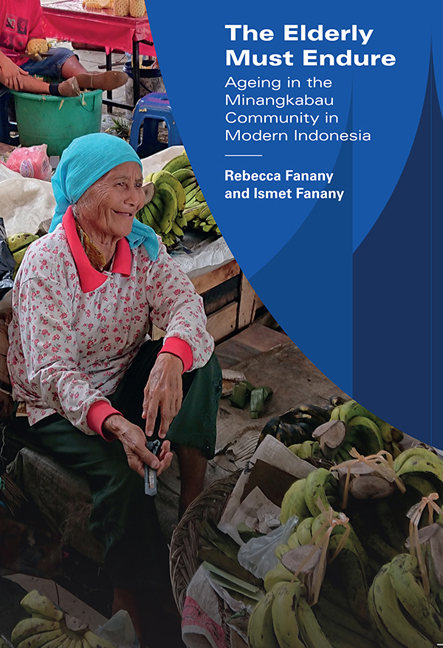Book contents
- Frontmatter
- Contents
- Acknowledgements
- Map of Indonesia
- Map of West Sumatra
- Map of the Village of Koto
- Aminah's Family Tree
- 1 Introduction
- 2 Ageing in the Past and Present
- 3 Adat Traditions and the Elderly
- 4 Religion and the Elderly
- 5 Language and the Elderly
- 6 Ageing in the Village
- 7 Ageing in Padang
- 8 Ageing in the Rantau
- 9 Ageing in an Institution
- 10 Ageing and Cultural Consonance
- 11 The Elderly Must Endure
- Afterword
- References
- Index
- About the Authors
1 - Introduction
Published online by Cambridge University Press: 16 May 2019
- Frontmatter
- Contents
- Acknowledgements
- Map of Indonesia
- Map of West Sumatra
- Map of the Village of Koto
- Aminah's Family Tree
- 1 Introduction
- 2 Ageing in the Past and Present
- 3 Adat Traditions and the Elderly
- 4 Religion and the Elderly
- 5 Language and the Elderly
- 6 Ageing in the Village
- 7 Ageing in Padang
- 8 Ageing in the Rantau
- 9 Ageing in an Institution
- 10 Ageing and Cultural Consonance
- 11 The Elderly Must Endure
- Afterword
- References
- Index
- About the Authors
Summary
THE VALLEY FAMILY
On a hot night in Jakarta, a dozen members of a large extended family met at a restaurant in one of the many residential neighbourhoods on the outskirts of the city. They thought of themselves as the Valley family because their traditional, multifamily home had been located in a hollow in their native village of Koto in West Sumatra. Some of the diners were siblings; others were first cousins. A few of their children, who had been born in Jakarta and were married themselves, also attended. Some of their spouses came from other parts of Indonesia and sat a short distance away from the older family members. Except for these younger relations by marriage, everyone present was a descendant of a single Minangkabau woman, the grandmother of the older diners named Aminah, who represented the founding generation of this matrilineal family. As it happened, she had had no living sisters so the family had contracted at her generation but had expanded again as her four daughters and two sons married and had children. This generation was the parents of the older people present, and those who remained alive on this date were around ninety years of age. Most of the diners were over sixty, the age at which Indonesia labels a person “elderly” (lansia), but a few were in their fifties and were approaching the time of life when they would have to make decisions about their future. Many of those present were already retired; all were middle class; and most had had a college education. As they ate, conversation turned towards a usual topic that invariably came up any time any of them met — their life in the village before they moved away. For most of them, that moment had occurred when they were in their early twenties, had finished their education, and decided to move to Jakarta to seek better opportunities than were available locally in West Sumatra, their province of origin. One of them had left the village much longer ago and, through a combination of circumstances, had grown up in the city of Makassar, in South Sulawesi, a province on another island in the eastern part of Indonesia. Eventually, everyone present married and had children.
- Type
- Chapter
- Information
- The Elderly Must EndureAgeing in the Minangkabau Community in Modern Indonesia, pp. 1 - 20Publisher: ISEAS–Yusof Ishak InstitutePrint publication year: 2018

